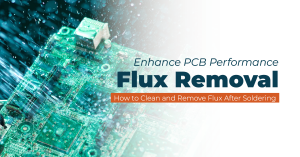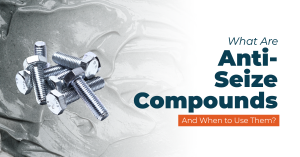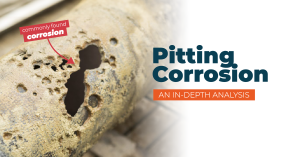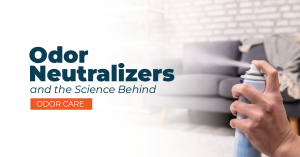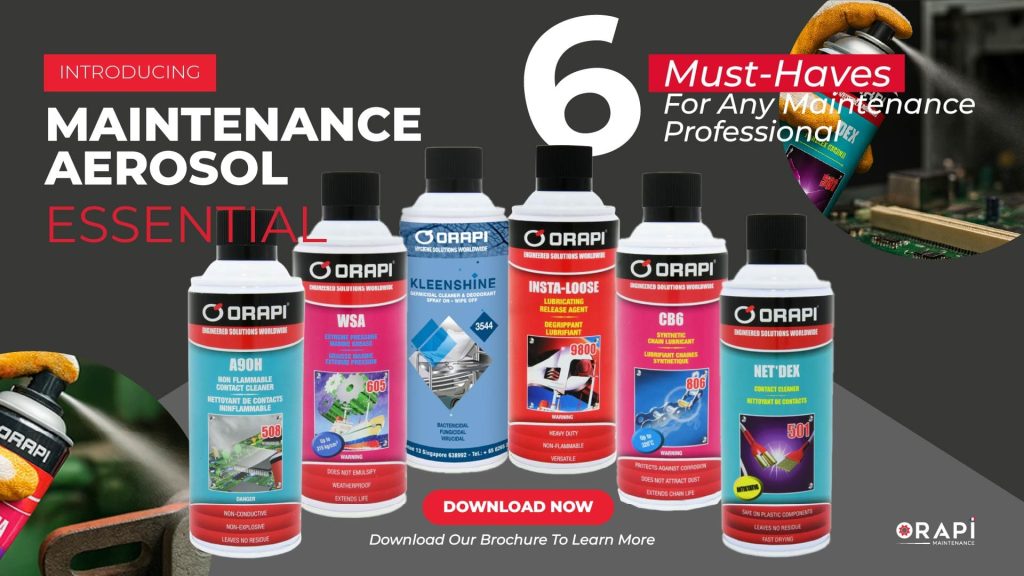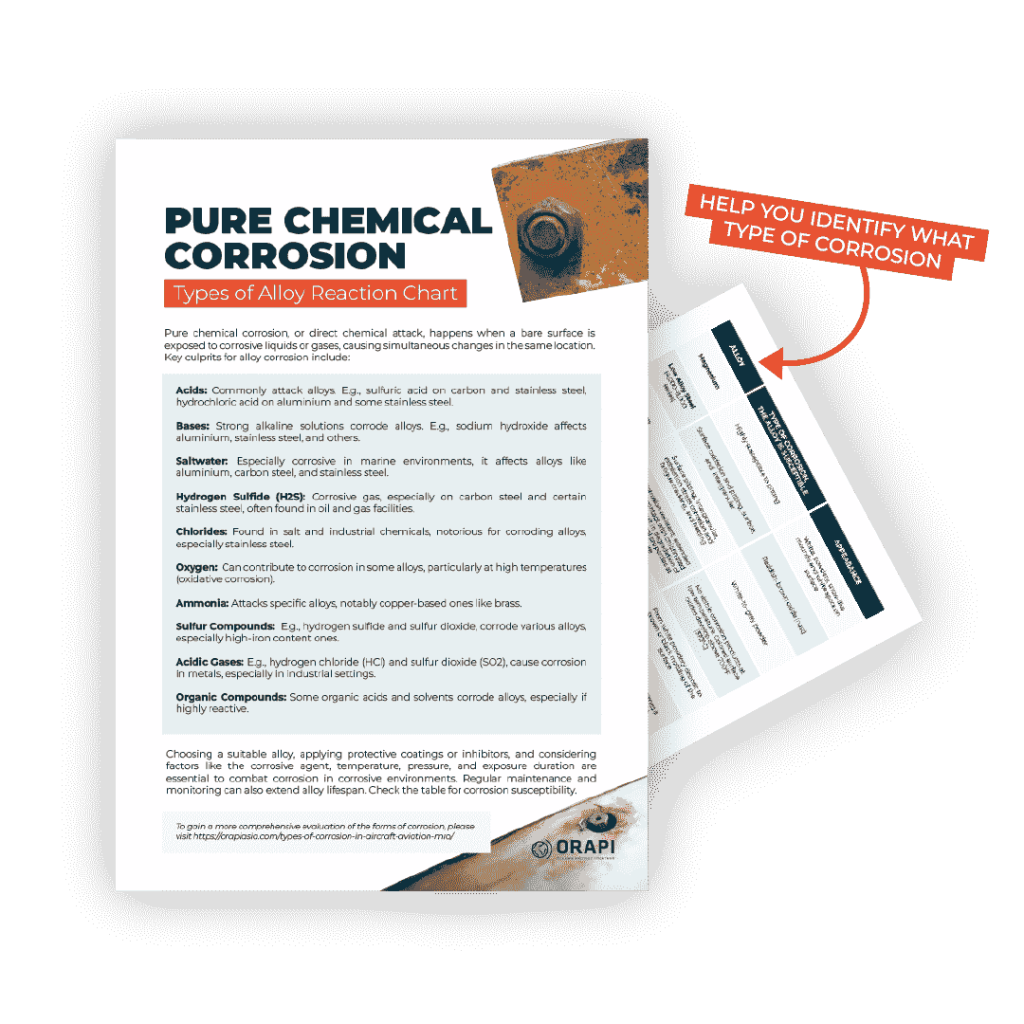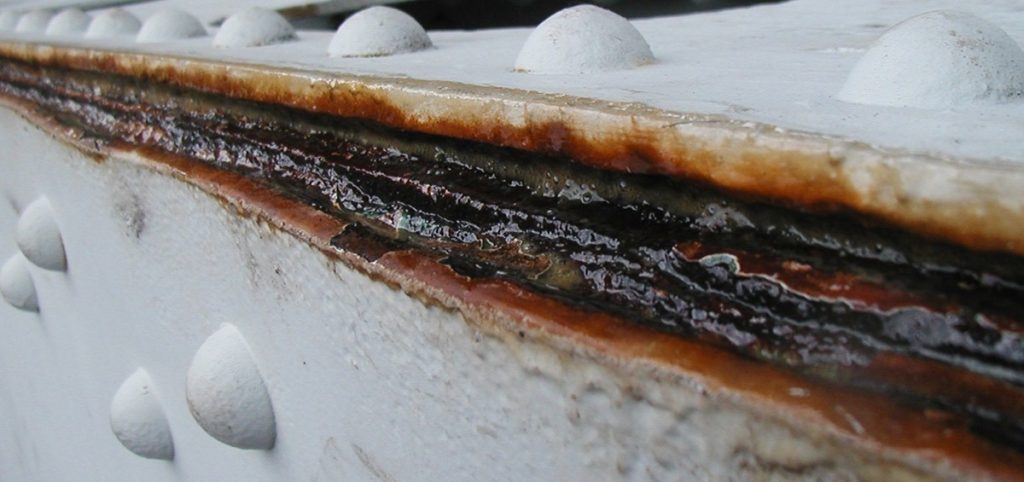
Numerous types of corrosion manifest visibly through extensive deterioration and discolouration. However, crevice corrosion initiates from a minute surface area and swiftly expands out of view within the metal, concealed beneath insulation or within tanks and vessels, resulting in potential component or structural failure without adequate warning. Thankfully, the origins of crevice corrosion are thoroughly understood. This guide not only explains the factors that promote this particular corrosion but also offers preventive measures, making risk mitigation a straightforward process.
What is Crevice Corrosion
Crevice corrosion is a type of localised corrosion that occurs within confined spaces or crevices formed between two surfaces. It manifests in various alloys like stainless steel, aluminium, titanium, and copper. This type of corrosion is localised and involves the breakdown of the passive surface layer within crevices or shielded areas under surface deposits. Intentionally created or ‘designed in’ crevices might be established at bolted joints, beneath flanges, between flanges and gaskets, or in contact areas such as valve seats.

Common Areas Prone to Crevice Corrosion
- Bolted and riveted connections
- Beneath washers, gaskets, and clamps
- Below insulation
- Along lap joints
- Within fastener threads
Mechanism Behind Crevice Corrosion

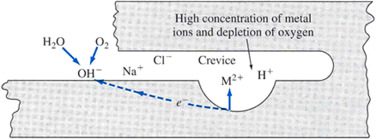
For corrosion to occur effectively, the crevice must facilitate the entry of corrosive electrolytes and create ‘stagnant’ conditions. The concern arises when gaps are a few micrometres wide, but there’s no absolute size threshold that guarantees corrosion.
Similar to pitting, crevice attack is a form of localised surface corrosion. The process involves two distinct phases: initiation and propagation. Various theories exist, with John Sedriks’ summary in ‘Corrosion of Stainless Steels’ providing valuable insights. Sedriks suggest initial general corrosion in a passive state. The anodic release of metal ions (M+) is counterbalanced by a nearby cathodic reaction that consumes oxygen from the surroundings. In a crevice, oxygen depletion can occur quickly, especially under stagnant conditions, impeding oxygen replenishment from the bulk solution. This ongoing reaction outside the crevice supports a corrosion cell, liberating metal ions in the anodic crevice, resulting in a buildup of positively charged metal ions. This progression leads to the well-known effects of chloride and pH on crevice (and pitting) corrosion.
The highly mobile chloride ion (Cl–) easily migrates from the bulk solution to the narrow crevice, attracted by the positively charged metal ions (M+). Metal chloride, typically involving chromium, formed in the crevice, reacts with water to create hydrochloric acid. Acid accumulation reduces the pH until a ‘depassivation pH’ is reached, breaching the passive film locally in the crevice, enabling the ‘pitting’ attack to continue.
Once depassivated, the attack accelerates and becomes self-sustaining, especially in the presence of ample chloride ions from the bulk solution. A less acknowledged point is that alloys are prone to corrosion at lower bulk chloride ion concentrations than those required for initiating pitting corrosion.
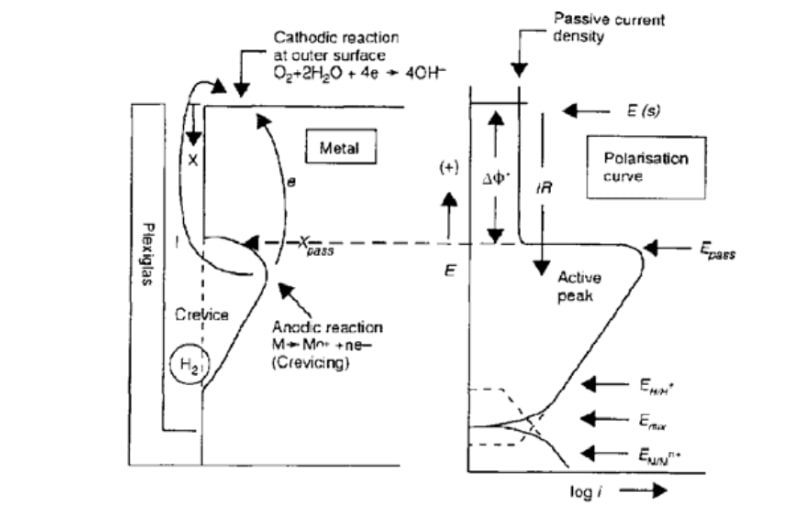
Fontana and Greene Model
The crevice corrosion mechanism, as per the Fontana and Greene model, unfolds through four distinct stages:
- Initiation Stage: Initially, corrosion occurs both within and outside the crevice. The anodic reaction takes place where metal (M) turns into positively charged metallic ions (Mn+), while the cathodic reaction involves the reduction of oxygen (O2) and water (H2O) to form hydroxide ions (OH-). The presence of OH- neutralises the positively charged metallic ions.
- Oxygen Depletion: Inside the crevice, the cathodic reaction exhausts most of the available oxygen.
- Chemical Exchange: Cl- ions and OH- ions diffuse into the crevice to stabilise the electrochemical potential. Metal chloride is formed, leading to the hydrolysis of metal chloride, which results in a decrease in pH (acidification), causing the formation of metal hydroxide and hydrochloric acid.
- Accelerated Corrosion: Continued attack by Mn+ ions on Cl- further decreases the pH within the crevice. This intensified metal dissolution generates more Mn+ ions, perpetuating a cycle of lowered pH and increased metal dissolution. This ultimately results in the acceleration of the corrosion process.
Factors Impacting Crevice Corrosion Risk and Severity
Diverse Crevice Types
Different behaviours are observed between metal-to-metal crevices versus metal-to-nonmetal crevices.
Physical Attributes of Crevices
Factors such as the size of the gap, depth, and surface texture in and around the crevice are important in influencing the risk and progression of corrosion.
Metallic Composition
Different alloys offer varying degrees of resistance to corrosion. Often, alloys that display strong resistance to pitting corrosion also exhibit improved resistance to crevice corrosion.
Environmental Conditions
Piping systems with ample space for electrolyte circulation and higher flow rates typically demonstrate greater resistance to crevice corrosion. This is attributed to reduced stagnant electrolyte pockets, and even when electrolytes are trapped, higher flow rates facilitate the exchange of trapped electrolytes with fresh ones, mitigating the initiation of corrosion.
Electrolyte Solution Characteristics
Factors such as solution temperature, pH levels, oxygen content, and presence of halide or chloride ions, among other traits, not only affect the risk of corrosion but also determine the aggressiveness of corrosion propagation once an attack begins.
Choosing Alloys to Prevent Crevice Corrosion
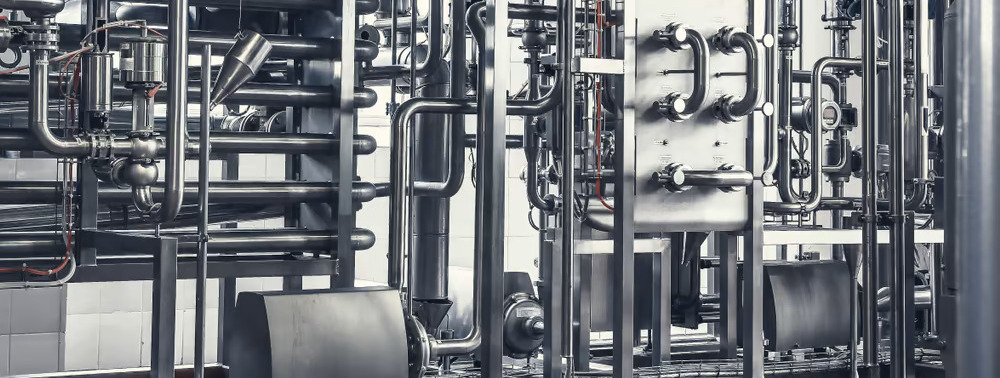
The resistance of passive layers in stainless steel relies on the promotion of chromium and the support from nickel. While chromium metal ions predominantly support anodic reactions in crevice corrosion more than iron or nickel, alloys with higher chromium content demonstrate superior resistance against crevice corrosion. Among stainless steels with the same chromium levels, austenitic types generally exhibit better resistance compared to lower-nickel ferritic variants. The presence of molybdenum and nitrogen significantly enhances resistance, with molybdenum aiding in slowing down the attack after depassivation occurs, typically leading to rapid attack.
In a broad context, stainless steel variants like 6% molybdenum austenitic and superduplex grades are anticipated to offer the highest resistance against crevice corrosion. As a reference point, the following common stainless steels are ranked in decreasing order of crevice corrosion resistance:
1.4547 and 1.4529 (6% Mo austenitic), alongside 1.4501, 1.4410, and 1.4507 (superduplex)
1.4462 (2205)
1.4539 (904L)
1.4401/1.4436 (316)
1.4301 (304)
1.4016 (430)
3 Categories of Coating to Prevent Crevice Corrosion
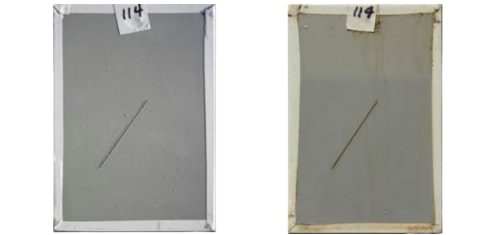
If your coating projects have a short lifespan, it’s likely that you haven’t chosen the most suitable system for the job.
Barrier Coatings
Barrier coatings create a physical barrier between the metal surface and the corrosive environment. They are typically non-permeable coatings, such as paints, epoxies, or polymer films. By forming a protective layer, barrier coatings prevent moisture, oxygen, and corrosive substances from coming into contact with the metal surface. This isolates the metal from the external environment, reducing the likelihood of crevice corrosion.
Sacrificial Barrier Coatings
Sacrificial barrier coatings, also known as sacrificial anode coatings, work by incorporating a sacrificial metal, typically zinc or magnesium, into the coating system. When the coating gets damaged or wears away, the sacrificial metal corrodes preferentially, protecting the underlying metal. This sacrificial action prevents the initiation of crevice corrosion because the less noble sacrificial metal corrodes before the base metal.
Chemically Active Corrosion Mitigation Coatings
Chemically active corrosion mitigation coatings are designed to release specific chemicals or inhibitors when exposed to a corrosive environment. These chemicals can neutralise or inhibit the corrosive process. For crevice corrosion prevention, these coatings release substances that can prevent the buildup of corrosive agents within crevices and pits. This inhibits the localised corrosion process and extends the lifespan of the coated metal.
Chemically Active Corrosion Mitigation Coatings

Design Considerations to Prevent Crevices
Ensure open junction points in the design. Eliminate intentional crevices in flanged or bolted joints, whether between metal-to-metal or metal-to-non-metal contact points. Insulating gaskets may not necessarily prevent corrosion. Emphasise good fit-up and adhesion of non-metal joints or gaskets to avoid crevice formation between different materials.
Fabrication Practices to Avoid Crevices
During fabrication, avoid crevice formation in welded joints by achieving full bead penetration. Complete root penetration is crucial, focusing on creating rounded and smooth beads without undercut in the internal bead to the parent metal area.
Operational Measures to Prevent Crevices
Prevent the accumulation of scale or sediment in tanks that can lead to crevice (shielding) corrosion. Consider implementing measures to prevent buildup or establish a routine cleaning/maintenance program, especially when some buildup is unavoidable.
Other Considerations to Prevent Crevice Corrosion
- Opt for butt weld connections over bolted or threaded joints in new equipment.
- Employ continuous welding or soldering to eradicate crevices in lap joints.
- Ensure thorough vessel drainage wherever feasible and design non-draining areas to facilitate ample solution flow, preventing stagnation.
- Utilise solid, non-absorbent gaskets when viable.
- Select alloys with superior ratings based on ASTM G48 standards to enhance resistance against crevice corrosion.
Key Takeaways
- Crevice corrosion necessitates two specific conditions: a gap between a metal surface and another metal or non-metal surface, along with the presence of a stagnant electrolyte.
- Detection of crevice corrosion might not be immediate and often requires close visual inspection.
- Minimising gaps, especially in welds and joints, can mitigate the risk of corrosion.
- Reducing risk involves ensuring complete drainage of vessels and eliminating electrolytes from surfaces.
- Mitigating risk at connections and equipment can be achieved using solid, non-absorbent gaskets.
- Materials demonstrating strong resistance to pitting corrosion often display high resistance to crevice corrosion as well.
Conclusion: Crevice Corrosion
In summary, crevice corrosion, though hidden, poses significant risks to metal alloys. Understanding its mechanisms and preventive measures is crucial. Factors like physical attributes, metallic composition, and environmental conditions greatly impact its severity. Choosing resistant alloys, careful design, fabrication practices, and operational measures are key defences. Vigilant inspection, gap minimisation, and efficient drainage remain essential for combating this insidious threat. By implementing these strategies, structural integrity can be preserved, ensuring safety and reliability in various metal-based applications.







